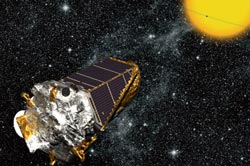Kepler spacecraft helps astronomers find tiny planet beyond our solar system

The Kepler spacecraft finds planets beyond our solar system by detecting changes in star brightness when a planet passes in front of a star. Larger image. Image by NASA/Kepler Mission/Wendy Stenzel<br>
The planet is about the size of the Earth’s moon. It is one of three planets orbiting a star designated Kepler-37 in the Cygnus-Lyra region of the Milky Way.
The findings were published online on Feb. 20 by the journal Nature. The lead authors are Thomas Barclay of the NASA Ames Research Center in California and the Bay Area Environmental Research Institute and Jason Rowe of NASA Ames and the SETI Institute in California.
Steve Kawaler, an Iowa State University professor of physics and astronomy, was part of a team of researchers who studied the oscillations of Kepler-37 to determine its size. “That’s basically listening to the star by measuring sound waves,” Kawaler said. “The bigger the star, the lower the frequency, or ‘pitch’ of its song.”
The team determined Kepler-37’s mass is about 80 percent the mass of our sun. That’s the lowest mass star astronomers have been able to measure using oscillation data for an ordinary star.
Those measurements also allowed the main research team to more accurately measure the three planets orbiting Kepler-37, including the tiny Kepler-37b.
“Owing to its extremely small size, similar to that of the Earth’s moon, and highly irradiated surface, Kepler-37b is very likely a rocky planet with no atmosphere or water, similar to Mercury,” the astronomers wrote in a summary of their findings. “The detection of such a small planet shows for the first time that stellar systems host planets much smaller as well as much larger than anything we see in our own Solar System.”
Kawaler said the discovery is exciting because of what it says about the Kepler Mission’s capabilities to discover new planetary systems around other stars.
Kepler launched March 6, 2009, from Florida's Cape Canaveral Air Force Station. The spacecraft is orbiting the sun carrying a photometer, or light meter, to measure changes in the brightness of thousands of stars. Its primary job is to detect tiny variations in the brightness of the stars within its view to indicate planets passing in front of the star. Astronomers with the Kepler team are looking for earth-like planets that might be able to support life.
The Kepler Asteroseismic Investigation is also using data from that photometer to study stars. The investigation is led by a four-member steering committee: Kawaler, Chair Ron Gilliland of the Space Telescope Science Institute based in Baltimore, Jorgen Christensen-Dalsgaard and Hans Kjeldsen, both of Aarhus University in Denmark.
Kawaler said Kepler is sending astronomers photometry data that’s “probably the best we’ll see in our lifetimes.” This latest discovery shows astronomers “we have a proven technology for finding small planets around other stars.”
That could have implications for some big-picture discoveries: “While a sample of only one planet is too small to use for determination of occurrence rates,” the astronomers wrote in the Nature paper, “it does lend weight to the belief that planet occurrence increases exponentially with decreasing planet size.”
Media Contact
More Information:
http://www.iastate.eduAll latest news from the category: Physics and Astronomy
This area deals with the fundamental laws and building blocks of nature and how they interact, the properties and the behavior of matter, and research into space and time and their structures.
innovations-report provides in-depth reports and articles on subjects such as astrophysics, laser technologies, nuclear, quantum, particle and solid-state physics, nanotechnologies, planetary research and findings (Mars, Venus) and developments related to the Hubble Telescope.
Newest articles

Combatting disruptive ‘noise’ in quantum communication
In a significant milestone for quantum communication technology, an experiment has demonstrated how networks can be leveraged to combat disruptive ‘noise’ in quantum communications. The international effort led by researchers…

Stretchable quantum dot display
Intrinsically stretchable quantum dot-based light-emitting diodes achieved record-breaking performance. A team of South Korean scientists led by Professor KIM Dae-Hyeong of the Center for Nanoparticle Research within the Institute for…

Internet can achieve quantum speed with light saved as sound
Researchers at the University of Copenhagen’s Niels Bohr Institute have developed a new way to create quantum memory: A small drum can store data sent with light in its sonic…





















